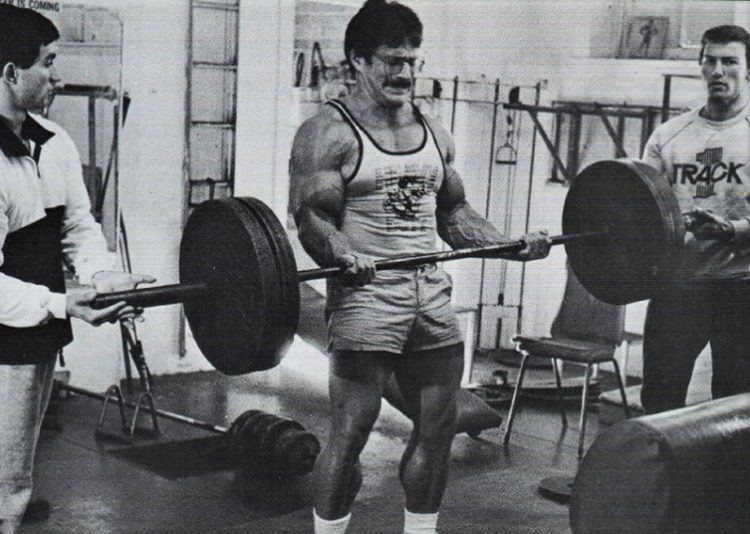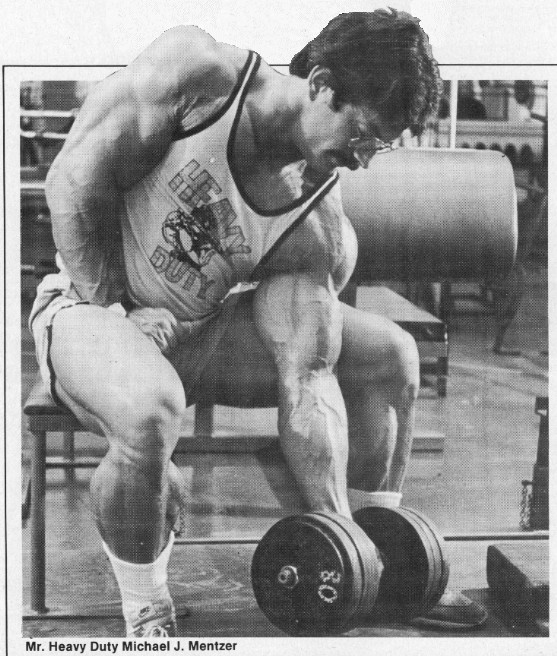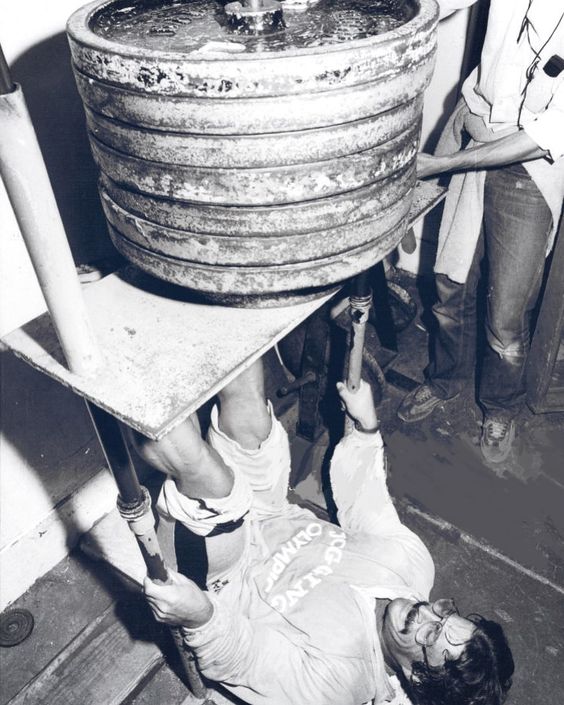When most people imagine a gym, they think of jacked guys lifting heavy weights while soaked in sweat — or at least, this is how I imagine it.
This style of training is known as high-intensity training (HIT).
Arthur Jones, of Nautilus fame, pioneered HIT training in the 1960s. This training protocol focuses on performing picture-perfect repetitions to mechanical failure, where you can’t perform additional reps with proper form due to muscle fatigue.
HIT training prioritizes the number of reps, the amount of weight, and time under tension to bias hypertrophy and strength gains.
Enter Mike Mentzer — “Mr. Heavy Duty”

Mike Mentzer learned about Jones and his training techniques after competing in his first bodybuilding show.
Level Up Your Fitness: Join our 💪 strong community in Fitness Volt Newsletter. Get daily inspiration, expert-backed workouts, nutrition tips, the latest in strength sports, and the support you need to reach your goals. Subscribe for free!
He became interested in Jones’ HIT techniques and dedicated considerable time to studying them. Mentzer believed Jones’ training principles were effective but opined that he could improve the programming to boost results.
Mentzer started training clients as an experiment to test his new HIT training program.
The bodybuilder evaluated different numbers of repetitions, exercises, and days of rest to achieve maximum benefits. Mentzer’s methodical training approach established him as a genius amongst his peers.
Finally, the Heavy Duty training regimen was born. This system involves short but brutally hard workouts that require pushing your muscles to (and sometimes beyond) failure.
Mentzer opined that weight training sessions must be brief, infrequent, and intense to attain the best results in the shortest amount of time.
In 1978, Mentzar became the first bodybuilder in history to win the Mr. Universe title with a perfect score of 300.
Mentzer’s blockbuster performance at the Mr. Universe was no fluke. He repeated the perfect score of 300 to win the heavyweight class of Mr. Olympia in 1979. However, he lost the overall title to Frank Zane.
Mentzer next competed at the Mr. Olympia, the world’s most prestigious bodybuilding show, in 1980 but slipped to the fifth position in what became one of the show’s most controversial decisions. Arnold Schwarzenegger won his seventh Olympia title at the show, staging an impressive comeback following a four-year hiatus from competitive bodybuilding.
In protest of the results, Mentzer retired from competitive bodybuilding after the 1980 Mr. Olympia at the age of 29.
Mentzer wrote five books on HIT training, making the principles accessible to people across the world.
Principles of the Mike Mentzer Heavy Duty System
Mentzer analyzed every aspect of a training program while developing the Heavy Duty system. Here are the core principles of his Heavy Duty system:
Limited Sets
The Heavy Duty training regime involves performing one working set per exercise.
Since this training regimen involves very few sets, you must make the most of them. Mentzer warmed up by performing a few sets of each exercise he would do in the workout. However, he didn’t push himself in the warm-ups to ensure he had ample energy for the working sets.
Mentzer believed that performing too many sets in a workout can lead to overtraining, which can hamper recovery and growth.
Intensity to Failure
With only one working set per exercise, Mentzer had to make it big.
Each Heavy Duty set must be performed to complete muscle failure. Although recent scientific research has shown that training to muscle failure in each set might not be necessary to promote hypertrophy, it can maximize muscle stimulation and muscle pumps. (1, 2)
The Heavy Duty system involves selecting a weight that leads you to muscle failure in the 6-9 rep range.
Mentzer believed that using heavier weights for six to nine reps is the most optimal way to maximize muscle fiber stimulation.
Low Frequency
Mentzer trained multiple muscle groups in a single workout. He was a proponent of training each muscle group once weekly.
Since Heavy Duty workouts involve full-send efforts, they necessitate longer recovery periods.
Mentzer rested for four to seven days after a training session, depending on the extent of muscle fatigue. That said, training at Mentzer’s level is not everyone’s cup of tea.
Depending on your training experience and fitness level, you must rest for at least 48 hours before training the same muscle group again.

Progression
Progressive overload in resistance training is key to consistent strength and muscle gains.
Once you can overshoot the target rep range with a given weight, you must increase the weight incrementally or reduce rest time between sets. (3)
Pro Tip: Use the smallest weight plates available at your gym to increase the weight on the bar. Lifting too heavy too soon increases injury risk.
Strict Exercise Technique and a Full Range of Motion
Although Mentzer lifted heavy weights, he did so with an exquisite form.
Perform each of the six to nine repetitions with a slow and deliberate rep tempo. Furthermore, you must prioritize a full range of motion to ensure maximal muscle fiber recruitment. Lower the weights if you can’t control the eccentrics, concentrics, or isometric contractions.
Rest-Pause
Although Mentzer’s Heavy Duty program comprises several advanced training principles, the rest-pause technique was his bread and butter.
The rest-pause method involves performing an exercise to mechanical failure, resting for 10 seconds, and then performing another set to muscle failure.
Sample Heavy Duty Workout Splits
A typical Heavy Duty training regimen has two weekly workouts.
Here are a few sample exercise splits for trainers of varying experience levels:
Beginner Lifters — Heavy Duty Workout
Here is the first weekly workout:
| Target Muscle Group | Exercise | Reps |
| Chest | Barbell bench press | 6-9 reps |
| Back | Pull-ups | 6-9 reps |
| Shoulders | Overhead press | 6-9 reps |
| Legs | Barbell squats | 6-9 reps |
This is the second beginner workout:
| Target Muscle Group | Exercise | Reps |
| Biceps | Barbell curls | 6-9 reps |
| Triceps | Close-grip bench press | 6-9 reps |
| Calves | Standing calf raise | 6-9 reps |
Since the Heavy Duty program is a high-intensity training regimen that involves lifting heavy weights, beginner exercisers should work under the guidance of a personal trainer to ensure they are using the correct exercise form.
Lifting heavy with a sloppy form can lead to ‘Heavy Duty’ injuries.
Intermediate Lifters — Heavy Duty Workout
The first weekly workout for intermediate lifters would comprise the following:
| Target Muscle Group | Exercise | Reps |
| Chest | Incline dumbbell press | 6-9 reps |
| Chest (Secondary) | Flat dumbbell flyes | 6-9 reps |
| Back | Bent-over barbell rows | 6-9 reps |
| Shoulders | Military press | 6-9 reps |
| Legs | Leg press | 6-9 reps |
Check out the second weekly training session:
| Target Muscle Group | Exercise | Reps |
| Quads | Leg extensions | 6-9 reps |
| Hamstrings | Leg curls | 6-9 reps |
| Biceps | Barbell curls | 6-9 reps |
| Triceps | Overhead tricep extensions | 6-9 reps |
| Calves | Standing calf raise | 6-9 reps |
Advanced Lifters — Heavy Duty Workout
You’ll be taking things up a notch in the advanced workouts. The number of muscle groups targeted in each training session will go down, but the intensity will shoot through the roof. You must go as heavy as possible while maintaining proper training form and full range of motion.
This split will involve three weekly workouts. Check out the first workout:
| Target Muscle Group | Exercise | Reps |
| Chest | Incline dumbbell press | 6-9 reps |
| Chest | Flat dumbbell press | 6-9 reps |
| Chest | Decline dumbbell press | 6-9 reps |
| Shoulders | Military press | 6-9 reps |
| Shoulders | Lateral raises | 6-9 reps |
Here is the second weekly workout:
| Target Muscle Group | Exercise | Reps |
| Back | Pull-ups | 6-9 reps |
| Back | Bent-over rows | 6-9 reps |
| Back | T-bar rows | 6-9 reps |
| Biceps | Barbell curls | 6-9 reps |
| Biceps | Hammer curls | 6-9 reps |
This is the final workout of the week:
| Target Muscle Group | Exercise | Reps |
| Quads | Leg press | 6-9 reps |
| Quads | Leg extensions | 6-9 reps |
| Hamstrings | Seated leg curls | 6-9 reps |
| Hamstrings | Lying leg curls | 6-9 reps |
| Triceps | Close-grip bench press | 6-9 reps |
| Triceps | Overhead tricep extensions | 6-9 reps |
| Calves | Standing calf raise | 6-9 reps |
Exercise Selection
Although Mentzer’s training regimen involves isolation exercises, compound movements are the foundation of Heavy Duty training. Since this training regime limits volume, multi-joint movements deliver the best bang for your buck.
The Science Behind the Heavy Duty Training Program
The Heavy Duty protocol is built on one belief: To build muscle, you must push it beyond what it is used to. You must learn about muscle fiber recruitment and the relationship between stimulus and recovery to understand why the Heavy Duty system works.
Level Up Your Fitness: Join our 💪 strong community in Fitness Volt Newsletter. Get daily inspiration, expert-backed workouts, nutrition tips, the latest in strength sports, and the support you need to reach your goals. Subscribe for free!
Muscle Fiber Recruitment
Here are the basics of muscle fiber recruitment and how you can maximize it:
Different Types of Muscle Fibers
Your body consists of fast-twitch and slow-twitch muscle fibers.
Fast-twitch muscle fibers are bigger, stronger, and have more growth potential. However, they also fatigue quickly. To train these fibers optimally, you must perform quick, intense exercise. This is where the Heavy Duty system excels.
On the other hand, slow-twitch fibers are better for endurance activities. Higher-volume workouts are more effective at training slow-twitch fibers.
Awaken The Muscles & Threshold Training
If you don’t use the fast-twitch muscles often, they become dormant.
Furthermore, everyday activities rarely require maximal effort, which minimizes fast-twitch muscle stimulation. Heavy Duty training kicks the fast-twitch muscle fibers into the top gear. Training near your threshold levels will ensure the target muscle fibers are doing most of the work.
Stimulus and Recovery Relationship
Here is how muscle stress and recovery play out in the Heavy Duty training method:
Shocking the System
Heavy Duty training involves shocking your muscles in each training session.
This is the best approach to avoid muscle and strength plateaus and guarantee consistent progress.
Prioritize Recovery
Forget about the golden era of bodybuilding; most bodybuilders of the present era would scoff at the idea of resting for four to seven days after a workout.
Mentzer took a radical stance and opined that recovery is where growth happens. The Heavy Duty system emphasizes the importance of recovery. It involves discerning whether you require additional recovery time after a training session.
Pro Tip: Performing high-intensity workouts every day can sabotage your gains by leading to overtraining and increasing the risk of injury.
Conquering the Heavy Duty Workout
Now that you know the basics of the Heavy Duty program, here is how to maximize your results:
The Warm-Up Protocol
A proper warm-up routine before a training session primes your joints, muscles, and tendons.
I highly recommend performing a 5 to 10-minute dynamic stretching routine pre-workout to get the blood flowing into the target muscles. Alternatively, you can do a short, low-intensity run on the treadmill.
Then, perform a few very light sets of the exercises you’ll perform in the workout to drill the movement mechanics.
Perfect Form and Execution
The Heavy Duty method involves moving heavy iron. Pumping big weights with an incorrect form can significantly increase injury risk.
Pick weights that allow you to maintain proper form and full range of motion. You must also contract the target muscles throughout the ROM to maximize muscle contraction. Avoid using momentum to limit secondary muscle engagement.
Taking it to Failure and Beyond
You must train to muscle failure in each set in the Heavy Duty program.
Then, use the rest-pause training principle to eke out a few more reps. If you’re not exhausted after each set, you’re not doing justice to Mentzer’s training regime.
When pushing personal bests, have a spotter nearby in case you need help.
Tracking Your Progress
Monitor your progress to ensure you’re on the right path.
Track the weights, reps, and exercises you perform in a workout. Tally your performance after each training session to eliminate the guesswork. Journaling how you feel and writing down exercise tips, if any, can also improve your performance in the future.
You could use a notebook or your phone’s notes app to jot down your progress numbers.
Nutrition Tips For the Heavy Duty Workout Program
Heavy Duty training is incredibly demanding.
Not only do you need optimal fuel to power your high-intensity workouts, but you also need proper nutrition to ensure the best muscle and strength gain results. Be mindful of the following aspects to maximize performance:
Macronutrients
Protein is the building block of muscle and the most important macronutrient for building muscle mass. Aim for 1 to 1.5 grams of protein per kilogram of body weight to boost hypertrophy. (4)
Carbs are the energy source for high-intensity workouts. Favor complex carbs over simple carbs to ensure a sustained energy release. Finally, eat healthy fats to maintain proper body functioning.
A 40:30:30 (carbs, protein, fats) macro split is a great place to start for beginners.
Whole Foods
Most of your macro and micronutrient intake should come from nutrient-dense whole foods.
Eliminate processed foods from your diet as they can lead to nutrient deficiencies, insulin level spikes, a rise in body fat percentage, digestive issues, increased inflammation, and lowered energy levels.
Junk foods negatively impact your hormones and can impair recovery.
Hydration
The human body is 70 percent water.
Drink at least a gallon of water daily to ensure optimal body functioning. It will help avoid dehydration and ensure an optimal supply of blood, oxygen, and nutrients throughout the body. Spread your water intake throughout the day to lower your body temperature.
Progressing on the Heavy Duty Program
Progression on the Heavy Duty program is a little different than most other training programs, as it imposes significant restrictions on the techniques you can employ. That said, here is how to progress on this plan:
Add Weights
Mentzer advised adding weights to make the exercises more challenging.
You can pile on more weight once you hit the target rep range (6-9) with good form. The number of reps you can perform will determine how much weight you should add. People who can perform nine reps can add more weight than people who can perform seven.
Keep the weight increments small to limit injury risk.
Exercise Variations and Advanced Techniques
Sticking to the same exercise over an extended period can lead to strength and muscle plateaus. Switch up the exercises routinely to keep your muscles guessing.
Employ advanced training principles like rest-pause and forced reps to train beyond muscle failure and maximize muscle stimulation.
Is Heavy Duty Right for You?
Although the Heavy Duty program is among the most effective training systems, the truth is that it might not be for everyone.
Each individual responds to an exercise regimen uniquely. What might work for you might not work for your training partner.
Here are the ideal candidates for Mentzer’s Heavy Duty program:
- Experienced Lifters: Heavy Duty is ideal for experienced lifters with a decent training form who can safely push their limits in each set. Beginners are at a heightened risk of straining their joints, muscles, and tendons on this program.
- People on a Plateau: Since this training regime involves lifting heavy weights, it is incredibly effective for breaking strength and muscle plateaus.
- Strength-Focused Athletes: The Heavy Duty program involves performing one working set to failure, making it suitable for lifters prioritizing strength gains.
The Heavy Duty program can be physically and mentally demanding. Since you’ll be dealing with maximum loads, it also significantly increases injury risk. You must learn to listen to your body. If an exercise doesn’t feel right, feel free to pull the plug on it.
Be open to experimenting with different exercises and techniques, and pay close attention to how your body responds and recovers between training sessions.
Conclusion
Mentzer brought high-intensity training to the mainstream. He also initiated the six-time Mr. Olympia champ Dorian Yates in the HIT realm. Mentzer’s Heavy Duty program is not for the faint of heart. Pushing yourself to the limit in each set requires grit and determination.
Depending on your training experience, pick one of the three training splits listed in this article and stick with it for at least eight weeks.
If you have any questions about Mike Mentzer’s Heavy Duty program, drop them in the comments below, and I’ll be happy to help!
References
- Lasevicius, T., Schoenfeld, B. J., Silva-Batista, C., Barros, T. S., Aihara, A. Y., Brendon, H., Longo, A. R., Tricoli, V., Peres, B. A., & Teixeira, E. L. (2022). Muscle Failure Promotes Greater Muscle Hypertrophy in Low-Load but Not in High-Load Resistance Training. Journal of strength and conditioning research, 36(2), 346–351. https://doi.org/10.1519/JSC.0000000000003454
- Hirono, T., Ikezoe, T., Taniguchi, M., Tanaka, H., Saeki, J., Yagi, M., Umehara, J., & Ichihashi, N. (2022). Relationship Between Muscle Swelling and Hypertrophy Induced by Resistance Training. Journal of strength and conditioning research, 36(2), 359–364. https://doi.org/10.1519/JSC.0000000000003478
- Plotkin, D., Coleman, M., Van Every, D., Maldonado, J., Oberlin, D., Israetel, M., Feather, J., Alto, A., Vigotsky, A. D., & Schoenfeld, B. J. (2022). Progressive overload without progressing load? The effects of load or repetition progression on muscular adaptations. PeerJ, 10, e14142. https://doi.org/10.7717/peerj.14142
- Wu G. (2016). Dietary protein intake and human health. Food & function, 7(3), 1251–1265. https://doi.org/10.1039/c5fo01530h














